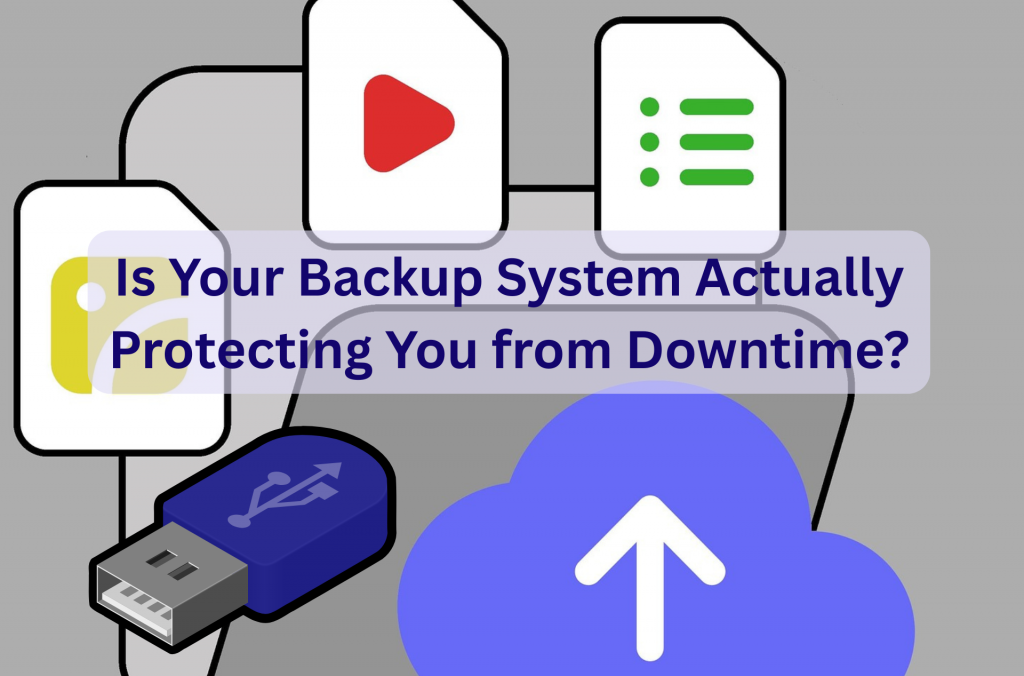Is Your Backup Really Keeping You Safe?
Data backups serve as the safety net of many small and mid-sized companies. However, there can be a false sense of security in these systems. This is because, if not managed well, a backup failure impact on downtime hits really hard. This is a real threat especially since in reality, businesses usually do not check their backups until they realize something is wrong during a crisis. Hence, every business must have a reliable managed IT provider to ensure that everything is working well, including the backups. This may require backup testing, data redundancy, and checking of other business continuity gaps to ensure that you will disaster recover and business continuity.

backup failure impact on downtime
Most Common Backup Myths
One of the most common myths in data recovery and information backup is that a backup is sufficient. However, it is possible that this backup may become outdated, incomplete, or corrupt. The other myth is that the cloud never fails, which is not entirely true. This is because even though cloud storage is resilient, problems can still happen such as improper settings, bandwidth, or slow internet connectivity. Because of these blind spots, businesses run a large risk from overconfidence and would only feel the backup failure impact on downtime when it happens.
Backup ≠ Recovery
Backup and recovery are two different things. Whereas a backup is simply a duplicate of files, restoring those files into working systems is recovery. However, although backup vs disaster recovery are different, both are essential to protect operations. This is because businesses can experience hours or even days of downtime with data backup but cannot use it without an established disaster recovery plan. Similarly, a recovery plan without backup data to recover is equally useless. Unfortunately, the effect of backup failure impact on downtime can only be felt when disaster has already struck.
Backup Types: Cloud, Local, Hybrid
Since backup vs disaster recovery are different, the different backups must also be noted. There are various strategies that are appropriate to different purposes. The selection of the appropriate method is based on the risk and recovery objectives. Some of the are the following:
Local backups
This kind of backup features fast data recovery, but vulnerable to fire, theft, or hardware failure.
Cloud backups
This option is usually resilient and off-site, but internet dependent.
Hybrid systems
In this set-up, the business gets the best of both worlds. This includes local backup’s speed and the security that comes with cloud backup.
Why Backups Fail in Emergencies
As mentioned above, backup systems, regardless of how robust, can break down. And backup failure impact on downtime can be disastrous especially for SMBs. Some of the most common reasons for this include lost files or applications as well as having old tools that cannot handle recovery loads. Additionally, improperly set schedules can also cause failure along with the absence of supervision or staff control. What is worse, because backup vs disaster recovery are different, is that such failures are normally undetected until downtime hits. When this happens, the losses and issues pile up.
Restore Time: The Overlooked Metric
Businesses have a tendency to measure the size of storage but disregard the restore time especially for cloud restore speed. Restoring a cloud can take minutes to a number of days. This depends on the internet bandwidth capacity and the amount of data. This is important to consider as each hour that is lost slows down sales, annoys customers, and reduces productivity. Every backup strategy must include a fast restoration, including cloud restore speed.
Do You Test Your Backups?
A backup without backup testing is of no value. Consistently testing the back-ups is important to check that files are restorable, that the systems can boot, and that the applications will run as they are supposed to. This is something that many SMBs and their managed IT providers overlook. As a result, it exposes them to business continuity gaps. Protection can only be assured by testing which a reliable, knowledgeable and experienced managed IT service provider like EB Solution should initiate for you.
The Role of Disaster Recovery Plans
A disaster recovery plan (DRP) is a document that determines how a company will respond in the face of an outage. This establishes communication guidelines, team roles, and system prioritization. A DRP will make sure that teams do not have to guess what to do next. Without it, there is a high chance of confusion which will contribute to more hours of backup failure impact on downtime.
From Snapshot to Live System
Snapshots save files, but do not ensure a functional system. Databases, apps, and integrations have to work together to facilitate recovery. It is a complicated process of transferring stored files to a live system. Planning fills this gap, and operations get back on track.
Managed Backup Services Explained
The majority of SMBs do not have the time and manpower to support advanced backup services. This is where a managed backup service comes in. In Canada, providers such as EB Solution provide continuous monitoring, automated backup testing, and recovery processes that are led by experts. Your managed IT service provider should be the one to see the unspotted vulnerabilities. In the same vein, they should be able to do something about them, so they do not become expensive downtime.
Business Continuity vs Data Storage
Saving information does not necessarily mean continuity. Business continuity refers to the uninterrupted flow of payment, customer service, and communication even when primary systems crash. This involves a combination of data redundancy, disaster recovery, and proactive monitoring. It will not be data that will save a business–it will be continuity of the operations despite the disruptions.
Must-Have Backup Policy Checklist
Any SMB is expected to have a definite backup policy. This checklist minimizes the gaps and enhances resilience. It includes:
- Keep three copies of all important data.
- Store them on two media (local and cloud).
- Keep a backup copy at a backup site.
- Perform routine backup tests.
- Establish recovery time objectives (RTOs).
- Give specific staff roles in recovery.
Final Assessment: Are You Really Covered?
Backups are reassuring, but that does not mean that it is safe. When systems cannot be tested, are slow to recover, or when recovery plans are not in place, the effects of the backup failure on downtime are expensive. This is a risk that Canadian businesses like you do not have to make. Here at EB Solution, we ensure preventative monitoring, back-up planning, data redundancy, and controlled IT solutions so that backups work as intended.
